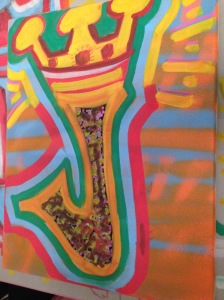Thinking Property in Law and Art by Brent Marks, third year law student at Sussex Law School (GDL Law).
As I was sitting down to write this blog I took a look back at the posts that Matilde and Mani contributed to the Street Law page and I was reminded of the benefits we’ve derived from the project so far. We have been welcomed into the thriving Brighton art scene with open arms. We spent a lovely afternoon touring the city with Sinna One, one of Brighton’s preeminent street artists. After several hours we’d seen some amazing pieces but had really only scratched the surface of what the city has to offer. This introduction has allowed me to appreciate new pieces that I encounter on my own travels around the city and at the risk of sounding cliché, I feel more a part of the community as a result.
But moving on, before I tear up here…
We also participated in an art therapy session at Art Schism with Sinna One, which was an enlightening experience for all. As Matilde wrote in her blog about that session, she had found herself taking an academic approach to art and I would echo that sentiment with regard to myself. As law students we tend to think very logically and analytically, governed by the confines of jurisprudence and legislation, but our afternoon at Art Schism was an opportunity to think differently. Sinna One encouraged us to ignore any previous conceptions we had about our artistic ability and to just get at it, and put pencil to paper so to speak. It was a refreshing change.
That said, we are still law students and we can’t just be drawing all day (unfortunately) so after those wonderful afternoons we had to sit down and answer some legal questions that surround Street Art. The questions were thus:
- If a client asks me to do a mural on the side of a building of which they are tenants, am I legally able to do this and if not then what are the consequences?
- What rights do graffiti writers and street artists have over their images, specifically if their work is photographed and used online?
In a legal context these are two very interesting questions, questions that do not arise in courts often. They both deal with the law that surrounds property, albeit two very different types of property: tangible and intellectual. Intellectual property law and the law that deals with tangible property such as land and chattels generally operate in mutually exclusive spheres, they do not often overlap. This is what makes street art such an interesting topic to examine legally.
The first question deals with the real property aspect, while the tenant may see the commissioning of a mural on the exterior wall as simply personalising the property – akin to changing the colour of the interior paint – their landlord is not likely to share this view. The issue of consent becomes very important, the property ultimately still belongs to the landlord, but to what degree should the tenant be allowed to take steps to personalise the space where they live. To what extent can they make autonomous decisions regarding the property?
The second question raises questions regarding the intellectual property rights that the street artists have over their work, specifically copyright. While a piece of street art may not have necessarily been done legally in relation to property to which it is fixated should that aspect of illegality completely extinguish any rights the artist has over their created work? A piece can be removed but it will be preserved through photograph, should the artist not retain the copyright over their work? On a prima facie basis, there is no reason why current copyright law cannot be adopted to cover the work of street artists. With the ease of the sharing of images via the Internet, street artists may be concerned with retaining these rights. As the popularity of this artistic genre increases these rights are becoming more lucrative.
I have purposely only addressed these questions quite basically, there are more detailed answers on this website, which myself and the other students involved have submitted. Please take the time to explore the answers to these questions. Like most questions worth investigating more questions have arisen, another layer of the onion has been peeled back.
Thanks again going to SinnaOne for his time and the questions he has posed, allowing us to think not just legally, but artistically, with some combination of the two, in relation to these fascinating questions surrounding property.

